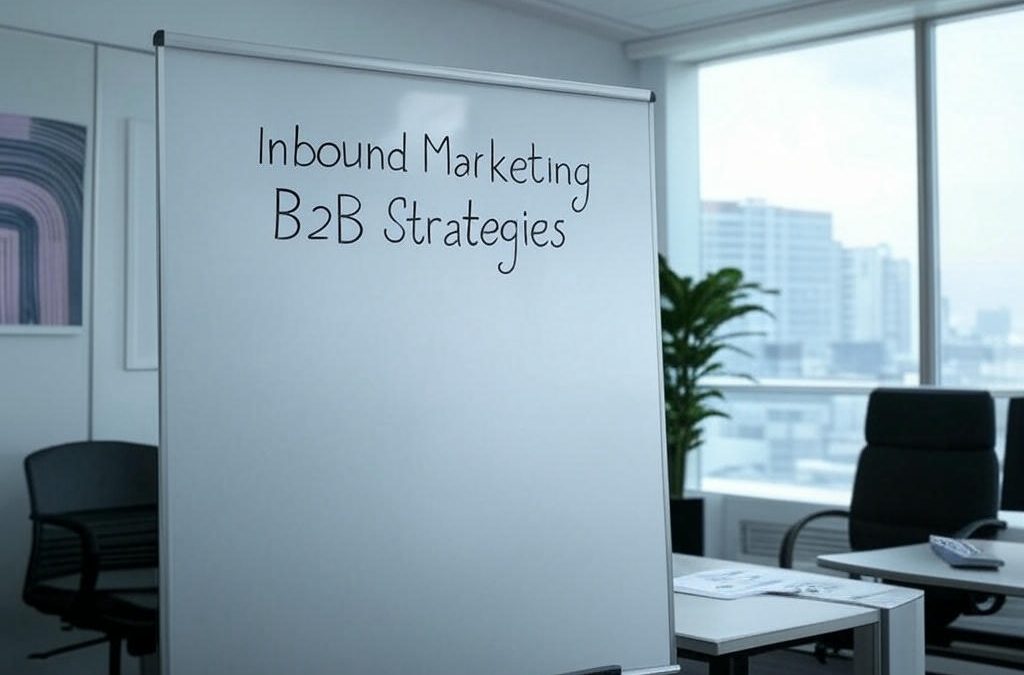Inbound marketing B2B is revolutionizing how companies connect with their target audience. Gone are the old-school methods of disruptive cold calls and generic mass emails. Today’s successful approach is all about providing real value and cultivating lasting relationships, which begins by creating great content.
The Power of Inbound Marketing B2B
Inbound marketing B2B represents a complete change in how businesses manage their marketing efforts. At its heart, inbound marketing focuses on producing valuable content and experiences designed for your ideal customer. Instead of pushing your message onto uninterested prospects, you attract them with information that’s both relevant and genuinely helpful.
The effectiveness of this approach is clear. According to the Demand Gen Report, 54% of B2B buyers use social media to research vendors.
This highlights the need for a strong inbound presence on platforms where potential customers are active.
Cost-Effective Lead Generation
A key advantage of inbound marketing B2B is its cost-effectiveness. Traditional outbound marketing can be costly and show diminishing returns. Inbound leads cost 62% less than outbound leads.
This difference in cost per lead enables better allocation of marketing budgets. Businesses can now concentrate on high-ROI strategies.
This approach makes inbound marketing a financially sound choice for many B2B companies.
Content is King in Inbound Marketing B2B
Central to a successful inbound marketing B2B strategy is the creation of high-quality content. This is more than just creating blog posts or social media updates. It involves crafting valuable content that tackles your audience’s pain points and offers real solutions, establishing a connection based on trust and expertise.
Approximately 53% of marketers prioritize blogging. This reflects blogging’s power in delivering useful information to your audience.
Consistent posting of top-notch content is essential. A marketing team needs a documented content strategy.
Key Strategies for Inbound Marketing B2B Success
Now that the importance of inbound marketing B2B is understood, it’s time to look into key strategies to help your business in the digital landscape. Here are some things to consider:
1. Develop a Robust Content Strategy
Your content strategy should serve as the foundation of your B2B inbound marketing efforts. This involves producing diverse content to accommodate different preferences. Consider where different customers are within the sales funnel when you are planning content.
A study by Business2Community shows that B2B marketers mainly use blog posts (89%), email newsletters (81%), and social media content (81%). Don’t limit yourself to written content. The use of video content among B2B marketers rose from 66% in 2022 to 75% in 2023, showing how important visual content is.
Use a variety of content types to increase engagement. Infographics and case studies can add interest, too.
2. Leverage Social Media Platforms
Social media isn’t just for B2C. It’s a powerful tool for inbound marketing campaigns, as well. Your business customers are also individuals spending time on social platforms.
Utilize these channels to share your content, interact with your audience, and cultivate relationships. LinkedIn is particularly valuable for B2B engagement, allowing you to connect with professionals and share industry insights.
Regularly posting and actively participating in relevant discussions can help you stay top-of-mind.
3. Implement SEO Best Practices
Search engine optimization (SEO) is essential to ensure your content reaches the target audience. Optimizing content for relevant keywords and providing valuable content increases visibility. You will rank higher in search results and draw in more organic traffic, enhancing your inbound marketing performance.
Use tools like Google Analytics to track keyword performance. Update your content to maintain relevance. Link building, both internal and external, further boosts your SEO by establishing credibility.
Consistent monitoring helps your marketing plan to remain up-to-date. Long-tail keywords can attract specific, high-intent users, so focus on niche terms.
4. Utilize Email Marketing
Email marketing remains crucial in B2B inbound marketing. 59% of B2B marketers claim email is the most reliable form of generating revenue, with a return on investment of $44 for every $1 spent. Use email to nurture leads, share valuable content, and keep your audience engaged with your brand.
Segment your email list to send targeted messages. Personalization boosts open and click-through rates. Automated email sequences can deliver timely content, guiding prospects.
Well-crafted newsletters keep your brand top-of-mind. A/B testing helps refine email campaigns, optimizing subject lines, and calls to action.
5. Embrace Video Marketing
Video is vital in B2B inbound marketing strategies. Video traffic will be 82 percent of consumer internet traffic by 2025. Video can help you connect with your audience.
Whether through explainer videos, product demos, or thought leader content, video can enhance engagement. Live videos and webinars can create interactive experiences. Hosting videos on your website can boost SEO, and sharing them on social media can broaden reach.
Consider using video testimonials from satisfied clients. It adds a layer of trust.
Case Studies: Inbound Marketing B2B Success Stories
To appreciate the impact of inbound marketing B2B, it’s helpful to review some real-world success stories. These instances provide practical insights into how different businesses have leveraged inbound strategies.
HubSpot: The Inbound Marketing Pioneers
HubSpot is a gold standard for B2B inbound marketing. They have a large library of free, high-quality content for their target audience. They have also established a community around their brand.
They also provide numerous templates, guides, and courses. HubSpot’s approach helps them draw in potential customers while reinforcing their authority.
By focusing on educational content, they have nurtured countless leads into loyal customers. This approach has enabled them to stand out as leaders.
Mailchimp: Content That Connects
Mailchimp is another B2B firm with great inbound marketing. They have a lot of resources for their small business audience. They’ve established themselves as partners in their customers’ growth by offering assistance that extends beyond just their services.
Their guides and design inspiration materials are user-friendly. This makes complex marketing concepts accessible.
By consistently delivering valuable content, they retain customers and foster a community around their brand. This is how Mailchimp built customer relationships.
Booxi: Aligning Teams and Reducing Costs
Booxi faced challenges in aligning teams across continents and reducing costs. They utilized inbound marketing strategies and HubSpot to enhance sales and reduce churn. The result was substantial.
They saved $100,000 per year and significantly improved team alignment. Booxi focused on making educational content that solved pain points.
By using targeted blog posts and webinars, they generated qualified leads. This enhanced operational efficiency, too.
Measuring the Success of Your Inbound Marketing B2B Efforts
To determine the effectiveness of your inbound marketing strategies, it’s important to track key metrics. Here are a few important things to consider:
| Metric | What It Measures | Why It’s Important |
|---|---|---|
| Website Traffic | Number of website visitors to your site | Indicates the reach of your content |
| Lead Generation | Number of new leads acquired | Shows how your content attracts potential customers |
| Conversion Rate | Percentage of visitors who take a desired action (e.g., form submission, purchase) | Measures how your content performs |
| Engagement Metrics | Time on site, pages per session, bounce rate, etc. | Indicates how engaging and valuable content is to visitors |
| ROI | Return on investment for your marketing efforts | Shows overall effectiveness of your inbound marketing strategy |
| Customer Acquisition Cost (CAC) | Total cost of acquiring a new customer | Helps evaluate cost-effectiveness of marketing campaigns |
Remember that successful inbound marketing B2B requires continuous improvement. Analyzing these metrics to make informed decisions helps.
Regular review and adjustment of your strategies ensure that your marketing efforts stay aligned. Tracking your progress helps you pinpoint what works and what doesn’t.
FAQs about inbound marketing B2b
What is B2B inbound marketing?
B2B inbound marketing focuses on creating valuable content tailored to attract business customers. Unlike outbound, inbound draws potential customers in with relevant and helpful content. This is instead of interrupting them with traditional ads.
It’s about attracting, engaging, and delighting your audience. It creates a relationship that naturally leads to conversions.
Blogs, ebooks, and webinars are common forms of content used. These are examples of content.
What are the 4 types of B2B Marketing?
Here are the four types:
- 1. Inbound Marketing: Attracting customers through content.
- 2. Account-Based Marketing (ABM): Focusing on specific, high-value accounts with personalized campaigns.
- 3. Content Marketing: Creating and distributing content to attract and keep an audience.
- 4. Digital marketing: Leveraging online channels like social media, email, and SEO.
Each of these types serves a different purpose. Combined, they help provide an approach that fits a range of business needs.
What is outbound vs inbound marketing B2B?
Outbound marketing B2B reaches out to potential customers through methods like cold calling and email blasts. Inbound marketing focuses on creating valuable content and experiences to attract them to you.
Inbound is typically seen as more cost-effective. Inbound marketing feels less intrusive.
Outbound methods can still have their place. Many find integrating both approaches can provide a comprehensive strategy.
What is an example of inbound marketing?
An example of inbound marketing is a company blog post offering content relevant to its industry. A software firm publishing articles about best practices in project management is an inbound example.
Such content can help to attract potential customers looking for information. It can subtly introduce them to the company’s solutions.
This helps generate interest and leads naturally, without the need for hard selling.
Conclusion
Inbound marketing B2B has changed how businesses interact with customers. Companies can get more qualified leads by emphasizing value and relationship-building. Reducing marketing costs and boosting sustainable growth helps, too.
Successful inbound marketing is a long-term strategy that aligns with your goals. The principles of inbound marketing can enhance connections, whether you’re starting out or updating current strategies.
As you advance in your inbound marketing B2B journey, remain adaptable. Keep measuring results and providing value. This proactive mindset will enable you to meet your audience’s needs and maintain a competitive edge in your industry.

